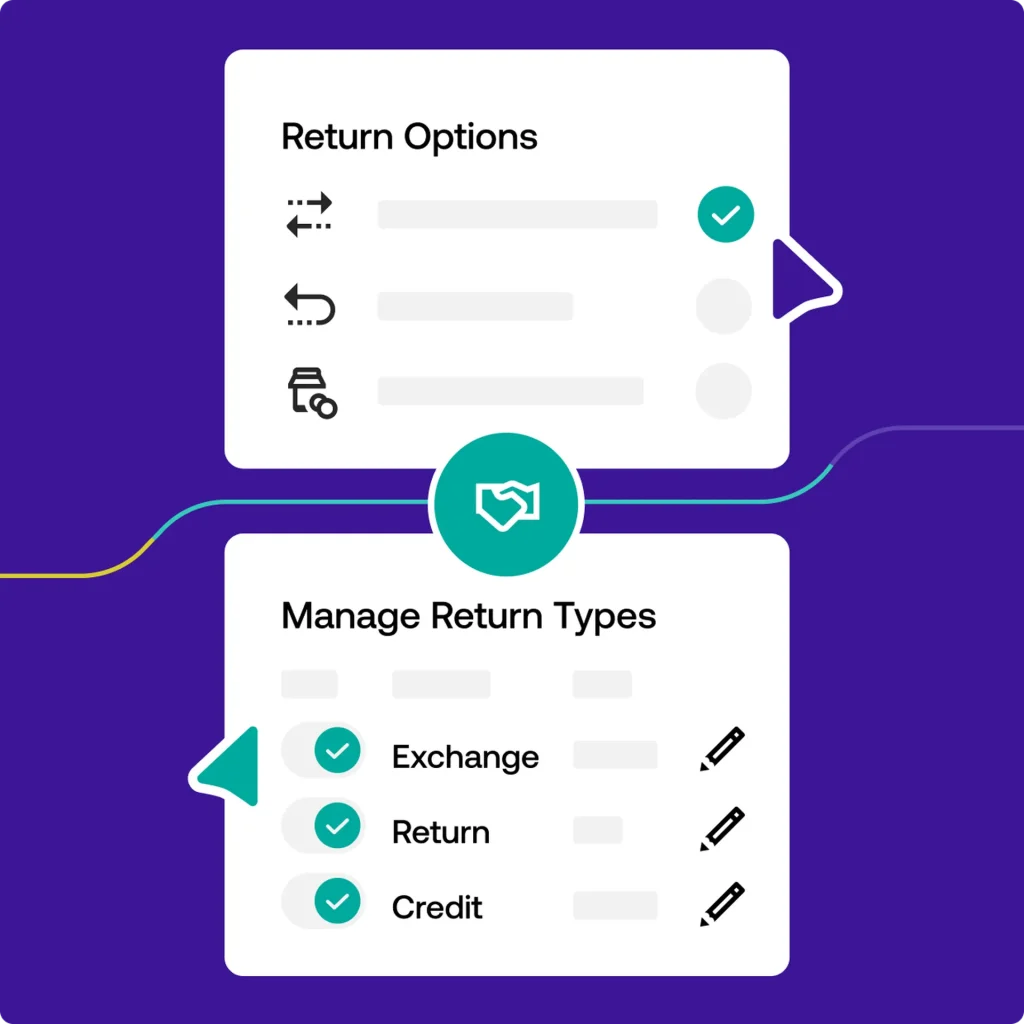Why Your Ecommerce Company Needs RMA Automation

As an ecommerce merchant, customer satisfaction is paramount. However, one often overlooked crucial aspect of online shopping that significantly impacts the customer experience lies in the returns process. With RMA automation, ecommerce merchants can create a seamless customer experience that helps them grow their business.
When shopping online, return rates nearly double. That means the returns experience can significantly impact how a customer may feel about your brand overall. A negative returns experience leaves shoppers feeling frustrated and discouraged from shopping with you again.
Leading ecommerce merchants effectively manage returns by relying on a Return Merchandise Authorization (RMA). RMAs, or Return Goods Authorization (RGA), is a process and system put in place by ecommerce merchants to manage and facilitate returns.
To truly understand the RMA meaning and how it could positively impact your business, we explore the importance of RMAs, what the returns process looks like without it, and how your ecommerce business can benefit from implementing an automated RMA system.
What Does RMA Automation Mean?

An RMA is an official agreement between a store and its customers that allows the return or exchange of products. It describes a shopper’s request for a return and a merchant’s acceptance of the return request.
Unlike in a manual process, online shoppers can initiate a return on their own with RMA automation. Once initiated, the customer success team can automate and approve a return based on the product information provided by the customer. This can include proof of purchase and a picture to confirm the quality of the product.
When an RMA request is created, customers receive an RMA number, also known as a returns authorization number. This number can be automatically generated by RMA software.
Return merchandise authorization numbers are unique identifiers that are assigned to each product return. This identification number simplifies tracking the status of each return. It also allows ecommerce merchants to provide immediate updates to all parties.
RMA automation helps ecommerce merchants streamline the returns process. No manual processing or data tracking is necessary with returns automation. It automates notifications and updates and extracts insights from returns data. RMA automation empowers merchants to grow their businesses.
In fact, optimizing returns with an automated RMA system helps customer success teams save an average of 15 minutes on each return. When hundreds of returns are coming in every month, shaving off 15 minutes per return can add up quickly.
All of that time given back to the customer success team can then be utilized in other areas of the business that help to further deepen customer relationships. With 88% of customers believing a business’s experience is as important as its products and services, this can prove to become a major win for business growth.
Manual RMA Process vs. RMA Automation

A manual returns process can be a time-consuming and frustrating experience for both merchants and customers. It typically involves a series of phone calls, emails, and manual data entry to complete each return. This lack of automation can cause delays in processing returns. It can also delay notifying customers about the status of their return requests.
All of this frustration can severely hurt the customer experience. Customers expect their problems to be solved quickly and easily when they initiate a return. Not delivering an efficient returns experience creates a bad perception of your brand. More often than not, shoppers won’t come back after a negative returns experience, making it extremely bad for business.
On top of that, a manual returns process becomes a nightmare for data tracking. Relying on the customer service team to manually input all the information from each return into spreadsheets or databases introduces a major risk of human error.
These mistakes in data entry lead to a collection of inaccurate data, which can cause further delays and confusion. Any errors in data entry can significantly skew returns data. This makes patterns and trends harder to identify. It also means any insights that are extracted will likely be inaccurate.
With RMA automation, all of this is taken care of for you. RMA automation eliminates the need for manual data entry and tracking altogether. At ReturnLogic, we track and store all returns data in a dashboard. This makes it simple to access information about any return quickly and use this data to analyze overall trends.
RMA automation systems provide comprehensive data analytics and reporting tools. This allows merchants to analyze returns data in real time. They can identify trends and gain valuable insights into product quality, customer behavior, and potential areas for improvement.
A manual returns process can be time-consuming, frustrating, and prone to errors. Real-time updates, data tracking, and meaningful insights are essential for operational efficiency. Without them, the customer experience is negatively affected.
RMA automation makes things simple. This system keeps customers, customer service, and warehouse and operations teams informed on the status of returns, no matter where it is in the process.
RMA Automation Makes Things Simple
Implementing RMA automation addresses the shortcomings of a manual returns process. Not only does it reduce time and frustration for customers and merchants, but it enables ecommerce merchants to optimize the returns process and grow their business.
To better understand how it works, let’s explore the stages of an automated RMA process:
- Customer Initiates a Request: Shoppers start the returns process by submitting a request through an online portal or customer service platform. With RMA automation, each request is captured accurately, minimizing errors and delays.
- RMA is Created: An RMA is automatically generated once a customer request is received. The customer receives a return authorization number, which serves as a unique identifier for the return. This makes it easy for customers and merchants to efficiently track and manage the return.
- Customer Packs the Product for Return Shipping: RMA automation streamlines the packing and labeling process by providing customers with clear instructions and pre-filled shipping labels. This reduces shipping errors and simplifies the return shipment for customers.
- Warehouse Receives Returned Product: RMA automation allows merchants to generate shipping labels for customers. This makes it easy for customers to return products. It also ensures consistency and traceability in the return journey.
- Product is Inspected and Processed: Once the warehouse team receives the returned product, they can conduct efficient inspection and processing. Integrating your automated RMA system with inventory management and quality control systems enables swift assessment and appropriate action.
- RMA Resolution: Automation can help ecommerce merchants quickly decide how to resolve each RMA. Options include a refund, exchange, or repair. Throughout the process, customers receive timely updates, which helps them feel informed. Customer contact is automated saving your customer success team valuable time.
Business Improvements with RMA Automation
RMA automation has revolutionized ecommerce merchants’ returns management processes. It has enabled them to unlock untapped potential. From improved operational efficiency to enhanced customer satisfaction and increased profitability, RMA automation has become a transformative force in the ecommerce landscape.
Ecommerce merchants can transform their approach to handling product returns by harnessing the power of technology and automation. Doing so results in improved operational efficiency, enhanced customer satisfaction, and increased profitability.
Here’s how:
Supplier Quality Management

With RMA automation, ecommerce merchants can embrace the power of data analytics. Returns data gives access to valuable insights that lead to informed decisions regarding supplier selection, performance evaluations, and contract negotiations.
It serves as a treasure trove of information for businesses, offering a comprehensive understanding of product returns and customer feedback. These insights help shed light on the root causes of product defects, malfunctions, or shortcomings.
By thoroughly analyzing returns data, companies can identify recurring issues that are directly linked to specific manufacturers or suppliers. Armed with this knowledge, ecommerce merchants can strengthen their relationship with suppliers by reaching out when they notice a manufacturing error.
Additionally, analyzing patterns and trends in return data enables companies to differentiate between reliable and problematic partners. Merchants can use this information to make informed decisions when choosing suppliers and manufacturers. These suppliers and manufacturers should be reliable and consistently provide high-quality products.
Prioritizing suppliers is important. They should have a track record of delivering products with minimal return rates and fewer recurring issues. This leads to a more reliable supply chain. Doing so will reduce the likelihood of product quality issues and improve overall customer satisfaction.
Product Design Improvements

RMA automation and returns data can also help ecommerce merchants by providing insights into product design flaws, functionality issues, and areas for improvement. These insights can help merchants improve their products and services.
Returns data serves as a rich source of information for ecommerce companies to gain an in-depth understanding of their products’ performance and customer feedback. It’s a great source to uncover true areas of frustration and what’s causing returns.
These insights help ecommerce merchants identify design flaws that may be contributing to customer dissatisfaction. By scrutinizing the returns data provided by RMA automation, merchants can pinpoint recurring issues, defects, or functionality concerns associated with specific products or product lines.
In the same way, returns data can help ecommerce merchants iterate on products and drive design improvements. By examining patterns and trends within returns data, companies can uncover opportunities for improvement.
This may involve enhancing specific features, optimizing usability, or refining manufacturing processes to eliminate known issues. RMA automation gives merchants the ability to systematically identify and rectify design flaws. This ensures that subsequent iterations of their products are of higher quality, more reliable, and aligned with customer expectations.
Returns data also offers insights into product durability and performance over time. Ecommerce merchants can identify common points of failure, weak components, or manufacturing defects that contribute to a product’s shortened lifespan.
Warranty Claim Automation

Returns data collected through RMA automation can also improve warranty durations and coverage. This leads to a better shopper experience, which increases customer confidence and trust. Many ecommerce merchants offer a warranty returns policy because it encourages product purchases and increases customer loyalty.
By offering shoppers a product guarantee, they feel protected from making an undesirable purchase. Customers expect their purchases to perform reliably. A warranty acts as a safety net that protects their investment.
However, the strength of a warranty policy is only as good as a merchant’s ability to follow through on their promises. Attempting to keep up with every warranty return request manually is a recipe for disaster. Ensuring validity and accurate data tracking while also providing an exceptional customer experience becomes close to impossible.
With warranty claim automation, this complicated and costly process becomes easy to track and manage. Customers, customer service, and warehouse and operations teams all get real-time updates on every warranty request, effectively minimizing frustration and miscommunication.
Additionally, using RMA automation for warranty coverage can help ecommerce merchants optimize warranty return policies to provide an exceptional customer experience. Understanding customer expectations is crucial in designing an optimal warranty policy. Aligning warranty coverage with potential product issues offers a sense of security to customers.
For example, if a particular product has a known issue after a certain period of use, extending the warranty duration for that specific component can help alleviate customer concerns and increase their trust in the product and brand.
Fine-tuning warranty durations and coverage allows customers to receive prompt assistance when they need it most. This not only resolves their issues quickly but also fosters a positive perception of the company’s commitment to customer support.
Returns data helps ecommerce merchants identify recurring issues and patterns. These issues and patterns may be indicative of product defects or design flaws.
This analysis enables merchants to take proactive steps to address customer concerns. They can do this by improving product quality or increasing warranty coverage. This will help to resolve any identified issues.
Automate the Returns Process with ReturnLogic
In a fast-paced ecommerce industry, the returns process plays a crucial role in maintaining customer satisfaction and loyalty. Managing returns manually can be a hindrance to ecommerce merchants. It causes frustration for customers and takes up the time of customer service teams, preventing businesses from success.
Implementing an automated RMA system revolutionizes returns management by addressing the challenges faced by a traditionally manual process. The returns data made available through RMA automation uncovers trends and patterns that can help to optimize supplier management, drive product design improvements, and refine warranty policies.
To stay competitive in the ecommerce industry, merchants must embrace technological advancements that streamline processes and enhance the overall customer experience. The power of automation in RMAs not only improves operational efficiency but also enhances customer satisfaction, reduces returns fraud, and enables data-driven decision-making.
Learn more about how RMA automation can enhance your ecommerce business by booking a demo with ReturnLogic today!

Automate your workload, not your customer experience.
- The average return takes 15 minutes to manually process
- The average manual return has 10 different touchpoints
- The longer a return takes to process, the less likely it is to get back into stock
Ready to simplify your returns management?
Schedule a free ecommerce returns audit today!








